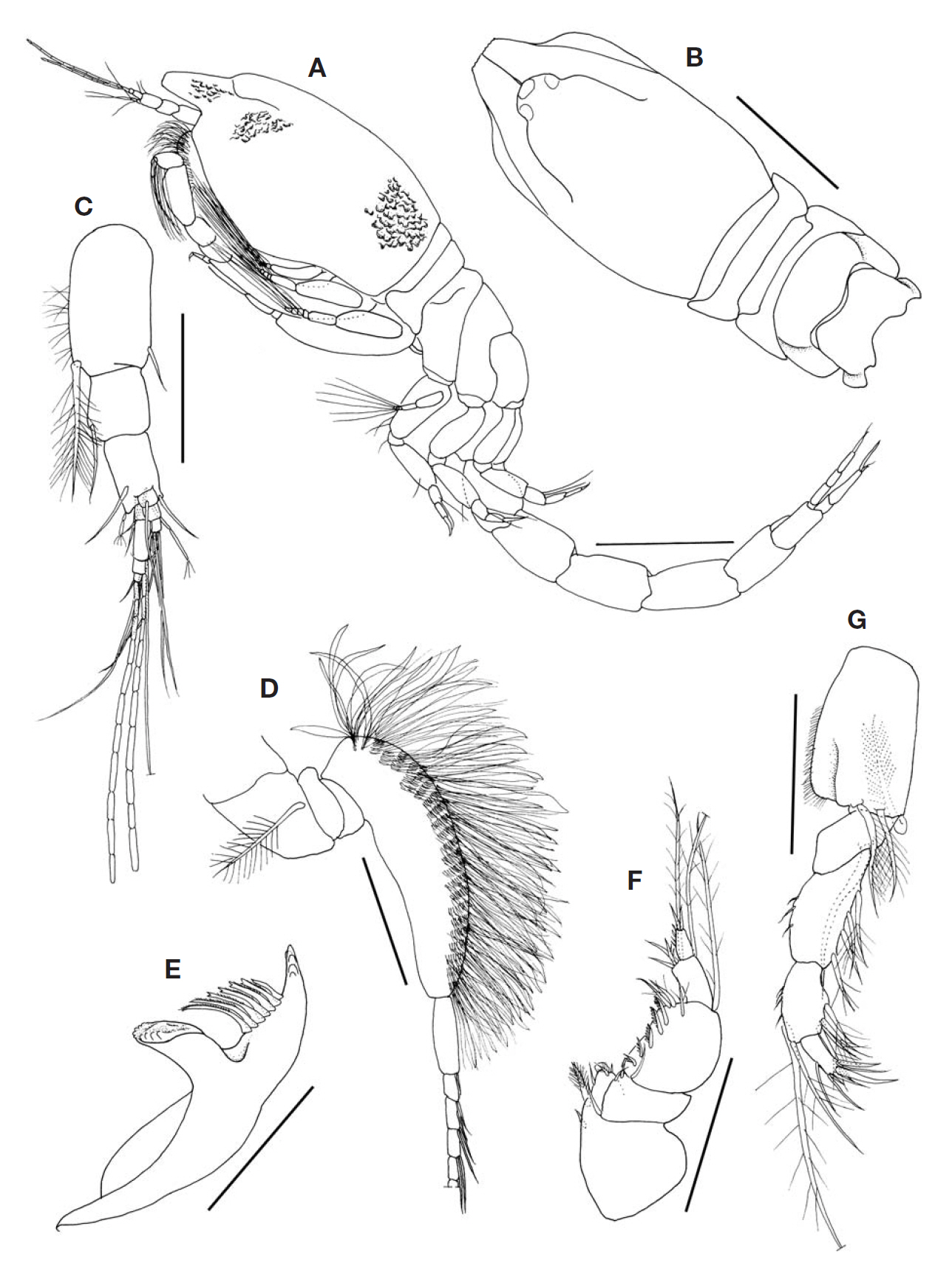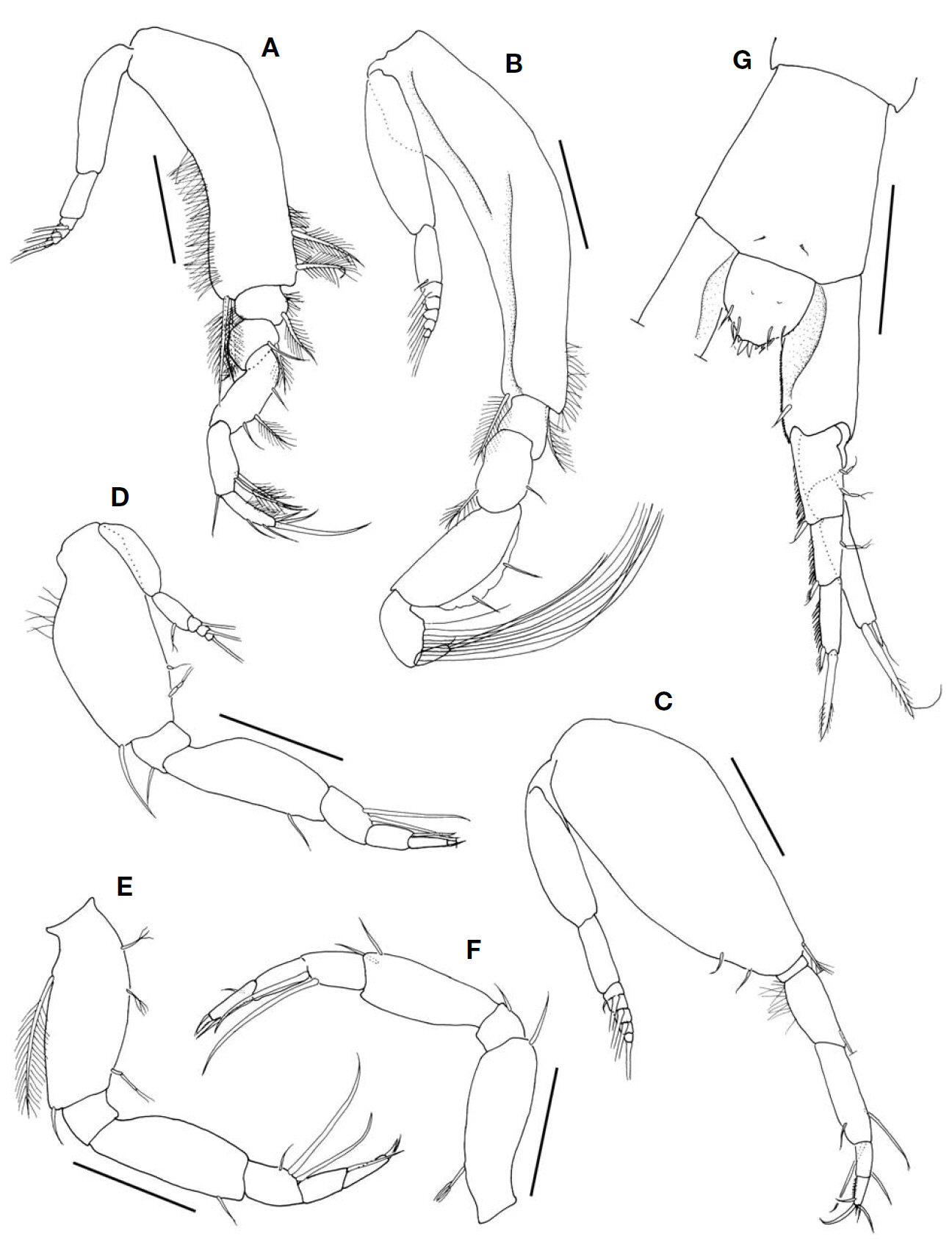



Gerken (2001) described 6 new genera and 45 new species of the cumacean family Gynodiastylidae, containing 103 species within 12 genera. Among them,
Until now, three species of the genus have been recorded in Korea:
A light-trap was used for collection of specimens from the shallow waters of the Yellow sea and South sea of Korea during 1999-2009. Drawings and measurements were performed with the aid of a drawing tube equipped on the light microscope. Body length was measured from the anterior tip of the carapace to the posterior end of the last abdominal segment. Lengths of appendages were measured along the mid-line of each appendage, exclusive of inflated outer angle.
Order Cumacea Kroyer, 1846
Family Gynodiastylidae Stebbing, 1912
Family Gynodiastylidae Stebbing, 1912
>
1*Gynodiastylis platycarpus Gamo, 1961 (Figs. 1, 2)
Korea: Incheon-si: 1♂, Dong-gu, Isl.Jakyakdo, 7 Oct 1998, Kim IH; 4♂♂, Ongjin-gun, Isl. Deokjeokdo, 20-21 Sep 1999, Lee CM; 1♂, Ongjin-gun, Isl. Daeyeonpyeongdo, 23 Aug 2000, Kim YH; 1♂, Ongjingun, Isl. Baekryeongdo, 25 Oct 2000, Kim YH; Gyeongsangnam-do: 1♂, Tongyeong-si, Isl. Bijindo, 9 Jul 1998, Lee CM; Jeju-do: 1♂, Seogwipo-si, Isl. Saeseom, 16 Feb 1998, Lee CM; Chungcheongnam-do: 1♂, Taean-gun, Isl. Anmyeondo, 21 Aug 2006, Kim YH; Jeollanam-do: 1♂, Yeosu-si, Isl. Geomundo, 17 Apr 2009, Kim YH .
Body length (Fig.1 A) 2.0-2.2mm, excluding telson and uropod. Carapace (Fig.1 A, B) slightly longer than 1/3 of body length, 1.65 times as long as its width, twice as long as its depth; shape nearly rectangular in dorsal view; surface glossy and rough. Antero-lateral corner obtuse. Pseudorostal lobe truncated, 1.65 times as long as ocular lobe. Ocular lobe much wider than long, with 3 lenses.
Thorax (Fig.1 A, B) 0.6 times as long as carapace length,
about 1/5 of body length; fifth segment longest.
Abdomen (Fig.1 A) 0.85 times as long as cephalothorax, slender; fifth segment longest.
Antenna 1 (Fig.1 C). Peduncle 3-articulated; first article slightly longer than remaining articles combined, with numerous hairs and 1 strong plumose seta distally on outer margin and 1 short simple seta on inner margin; second article with 1 simple seta on outer corner; third article with 4 simple distal setae, 2 sensory seta on surface and distal margin. Main flagellum 3-articulated; second article very long, with 1 long simple seta and 1 aesthetasc on distal margin; third article very small, with 1 short simple seta and 1 aesthetasc on terminal margin. Accessory flagellum 3-articulated, subequal to 1/2 length of main flagellum.
Antenna 2 (Fig.1 D) very short, not exceeding carapace. Peduncle 5-articulated s; second article with 1 plumose seta on surface; flagellum 9-10 articulated, first article very long.
Right mandible (Fig.1 E) with 1 simple seta and 6 serrated setae (4 of them bifurcated) between pars incisiva and pars molaris; pars incisiva with 5 teeth.
Maxilliped 1 (Fig.1F). Carpus of protopod with 3 plumose setae, 5 comb-like specialized setae near inner margin; outer corner with 1 long plumose seta. Endite with 1 strong plumose seta and 2 simple setae on inner margin, and 1 tooth and 2 simple setae on terminal margin.
Maxilliped 2 (Fig.1 G). Basis about 0.55 times as long as remaining articles combined, with 3 strong plumose setae on distal margin. Carpus with 4 plumose setae on inner margin and 3 short simple setae on outer margin. Dactylus about 0.55 times as long as propodus, with 1 simple seta on outer margin, and 1 strong spiniform seta and 5 simple setae on terminal margin.
Maxilliped 3 (Fig.2 A). Basis 1.3 times as long as remaining articles combined, with numerous hairs on outer margin, 3 long plumose setae on outer corner, and 2 plumose setae on inner margin. Propodus with 2 plumose setae on inner margin and 1 simple seta on outer corner. Dactylus about 0.8 times as long as propodus, with numerous hairs on inner margin, 2 simple setae on outer margin, and 2 simple setae and 1 long spiniform seta on terminal margin. Exopod well developed.
Pereopod 1 (Fig.2 B). Basis 1.1 times as long as remaining articles combined, with 1 plumose seta, numerous hairs near inner corner, and 1 plumose seta on outer corner. Carpus 1.85 times as long as propodus, with 2 simple setae and 1 membranous lamella on inner margin. Propodus with approximately 9 very long setae. Exopod well developed.
Pereopod 2 (Fig.2 C). Basis 1.3 times as long as remaining articles combined, with 1 plumose seta; inner margin with 2 simple setae. Carpus very long, 1.3 times as long as merus, with 1 simple seta on outer margin, 1 simple seta on inner margin, and 1 simple seta on terminal margin. Exopod well developed.
Pereopod 3 (Fig.2 D). Basis about 0.75 times as long as remaining articles combined, with 2 sensory setae on outer margin and 1 simple seta on inner corner. Exopod well developed.
Pereopod 4 (Fig.2 E). Basis about 0.6 times as long as remaining articles combined, with 1 long plumose seta on outer margin, 1 simple seta on outer corner, and 3 sensory setae on inner margin.
Pereopod 5 (Fig.2F). Basis about 0.55 times as long as remaining articles combined, with 1 simple seta on outer corner and 1 sensory seta on inner margin.
Telson and Uropod (Fig.2 G). Telson small, 0.4 times as long as last abdominal segment; dorsal surface with 2 pairs of simple setae; both lateral margins with several spinules; terminal margin with 1 pair of spines. Uropodal peduncle 0.75 times as long as last abdominal segment, with 1 spines on inner margin. Endopod 3-articulated, 1.5 times as long as peduncle; each of articles with numerous spinules on inner margin and 1 spine on inner corner; terminal margin with 1 long spine. Exopod 2-articulated, 0.85 times as long as endopod; second article with 2 apical spines, one of them very long and plumose.
Korea (Yellow Sea, South Sea) and Japan.
>
Key to the species of the genus Gynodiastylis in Korea
1. Surface of the carapace smooth, without any ornament ???2
- Surface of the carapace pitted, with several ridges ????????3
2. Telson longer than the last abdominal segment; uropodal endopod unarticulated??????????????????????
- Telson shorter than 1/2 length of the last abdominal segment;uropodal endopod 3-articulated ?????????????????????????????????????????????????????????????????????????????????????????
3. Surface of the carapace covered with numerous reticulate sculptures; uropodal endopod longer than 1/2 peduncle in length ?????????????????????????????????????????????????
- Surface of the carapace covered with alveolate sculptures; uropodal endopod shorter than 1/2 length of the peduncle??????????????????????????????????????????????????????????????????
Korean name: 1*작은꼬리코올챙이새우(신칭)

